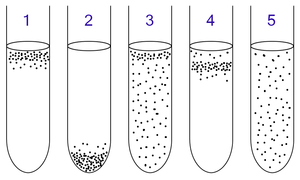All nature is DESIGNED to illustrate the word of God.
From the creation of the world, God’s invisible qualities, his eternal power and divine nature, have been clearly observed in what he made.
As a result, people have no excuse.
Rom 1:20 GW
Counterpart study has three parts, like a sandwich:
The top part–one independent system (A)
The “insides” that make the sandwich worth your time–corresponding principles of action
The bottom part–another independent system (B)
As we launch into our study on Sandwiches we will be looking at two worlds, the physical and the spiritual, and four sets of counterparts. These are the top and bottom slices of bread in each sandwich. For one side we will use an element from the Periodic Table that is necessary for physical life. (Of course there is much more that is needed, but as far as being classified as organic each of these 4 elements must be present. Don’t worry, it won’t get over your head!) For the other side we will use an element of spiritual life (simple things that you will immediately recognize as important without having to be a Bible scholar). Then between these two worlds will be the part that really makes the “sandwich”–characteristics that are shared by the elements on both sides. When we are through we will have four “sandwiches” that are used to determine physical and spiritual life. Simple. Afterwards, we’ll take one of the counterpart “sandwiches” and use it in a different way, so you can see how applicable they can be.
PHYSICAL To determine if something is organic (living or derived from living organisms) or inorganic (never having lived nor originated in a living organism), scientists look for four basic elements. If all four are present then the possibility of life is high. However, if any one of the four is missing, then the object is classed as inorganic.To garden plants these four are considered “heavenly” elements because all are in our atmosphere. And from that resource life as we know it is constructed.
HYDROGEN begins the Periodic Table of Elements. It has an atomic number of 1. There is no element that comes before it. When two hydrogen atoms join in the environment of suns, much energy is released and helium is made. Helium has an atomic number of 2. Theoretically, then, all elements can be considered a development of hydrogen. Hydrogen, besides being the first of all the elements, is also the lightest and most abundant in the universe. It is the only element without a neutron.
CARBON, with an atomic weight of 6, is used as a structuring or foundation element and is very stable. To best serve the universe carbon must assume many different forms. By arranging the atoms in different patterns, carbon can form hard and transparent diamonds, or soft and lubricating graphite, or graphene, with a breaking point 200 times greater than steel, or even dirty, black soot. All are pure carbon with just a different atomic arrangement.
NITROGEN, 7th in line in the elements, has one of the strongest and tightest bonds in nature. It takes a lot of energy (like a bolt of lightning) to separate two nitrogen atoms. Nitrogen makes one of the few inorganic “signaling” compounds known—a molecule used to convey messages to other parts of an organism. This element acts as a communication bridge in nature, like in chlorophyll, hemoglobin, and Vitamin B12. A chlorophyll molecule is composed of a single magnesium atom surrounded by 4 nitrogen atoms that connect it to the rest of the molecule. Hemoglobin has the same arrangement, except a molecule of iron sits on the “throne”. Vitamin B12 uses cobalt as the central atom and also surrounds it with 4 nitrogen atoms.
OXYGEN, the 8th element in the Periodic Table, is the life force in our world, whether in its pure state or combined with other elements, as in carbon dioxide. It can be highly reactive, a power element that helps things burn hotter and brighter. (Heat or light is often required to effect a permanent change.) To many forms of life this element is their very breath. Oxygen combines readily with other elements to form useful and vital compounds.
Since the book of nature and the book of revelation bear the impress of the same Master Mind, we should not be surprised to learn of a similar quartet in the spiritual realm, something to identify the presence or absence of spiritual life. These two quartets would speak in harmony, bearing witness to the same truths (the middle part of the sandwich) , though through different methods and in different languages. Both the natural and spiritual realms shed light upon each other and better acquaint us with God.
SPIRITUAL Yes, spiritual life on this earth can also be identified by four “elements”. To determine if a teaching or person is of God or not, we must look for four basic characteristics, just as we do in the material world for physical life. If all four components are present then the possibility of spiritual life is high. However, if any one of the four is missing, then the teaching or person should be considered spiritually inert. The following four elements correspond to the first quartet.
TRUTH answers to HYDROGEN, the simplest of all elements and the only one that has no neutrons. In truth there is no “neutral ground.” God’s nature is love, and truth is the first expression of it. Nothing comes before truth. It is ever-present in God’s kingdom. There is nothing that God has created or done that is not based on truth. As we draw closer to Him we will draw closer to truth1. As we learn to love God more we will learn to love His truth more2. Truth will be in every business transaction, in every discourse, in every judgment of His children. Whatever is not of truth will be avoided by God’s followers. The Christian life is recognized by our response to Truth— by our belief in it and obedience to it.3
SERVICE is how love meets the needs of those around us in helpful, useful ways. Though the ways we do this must by nature be quite varied, we can always maintain our purity in the process, just like CARBON does in the physical world. Service not only defines the Christian life, also like CARBON it provides the framework for it.4 The Christian life is identified by who and how we serve.5
COMMUNION is love’s expression for bonding us with God and others. As NITROGEN is 7th in the list of elements and the element for bonding and communion, so is the 7th day of Creation. It was made, blessed, and set apart for this very purpose. Relationships are very important in the Christian life. We were designed for fellowship with God6 and one another7. Relationships are based upon an interchange of thoughts and feelings, of sympathizing, communicating, sharing, opening up to one another. Communion is the substance of worship, an intimate sharing of thoughts and feelings with the Creator/Saviour, and being sensitive to His thoughts and feelings. The Christian life is identified by the kind of bonding relationships we have with God and with each other, and is best expressed among the elements by NITROGEN. In Revelation we see the identical “bridging” pattern of nitrogen in the spiritual realm. The Lamb sits on the throne and is surrounded by 4 beasts,8 which lead out in worship9 and communicating God’s will.10
GRACE reveals the abundant, practical, vitalizing nature of God’s love. It is the counterpart of OXYGEN. Grace is God’s undeserved and unearned kindness and favor to sinners. Through this divine attribute comes power and motivation for living11 and making permanent changes.12 Like with OXYGEN, wherever we turn we find evidences of grace present in our world, actively combining with nearly everything around us, and energizing whatever it is associated with. There could be no life nor growth in a sinful world without Heaven’s unmerited favor in one form or another, whether in its pure form or combined with mercy, truth, or forgiveness. The Christian life is identified by the presence and evidence of God’s grace in everything redeemed sinners do. OXYGEN’s place in the Periodic Table of the Elements is in the 8th position, a fitting number in the Hebrew language where eight denotes plumpness, a surplus above the perfect seven.
As you can see, these analogies appear more designed than happenstance. Their consistencies open a whole world of study and research as we compare divinely designed similarities, using one to better understand the other.
ONE APPLICATION Let’s take the OXYGEN/GRACE sandwich for an example how counterparts can be applied many other ways, once we get the connection. Grace is God’s power offered us to become like Him and to do His will. It surrounds us like the life-giving atmosphere surrounds our earth and is offered to us freely. All we need to do is open the windows of our soul wide and breathe in its free, invigorating, life-giving power. There is no charge for this service.
It would seem that doing so would be the natural thing for all God’s creatures to do, that everyone would not only want this proffered gift but desperately seek it as we do life-sustaining oxygen—the most abundant element in our body. But sin has done a terrible work in our hearts and in our world. Grace is not seen as necessary anymore by many.
Today there are five attitudes toward God’s unmerited favor.
A. Christ’s true disciples: Grace, where is it? I must have it!
B. Laodiceanism: I really do need God’s help, but only in tiny portions. I can do most of it myself.
C. Humanistic influence: God’s unmerited favor is nice, and even helpful at times, but there are many other ways that are just as effective.
D. Babylonian influence (they worshiped “Ba’al”, which can refer to any or all gods): Grace? I don’t know what it is really, but, hey, whatever turns you on, go for it. Just bring your god and join us in a good fellowship.
E. Lucerferin influence (Satanism or the worship of self): I want no part of anything that comes from Jesus or God. I love darkness and am fascinated by evil.
These 5 attitudes can be illustrated by how different bacteria relate to oxygen (grace’s counterpart). By filling test tubes with a liquid culture and then inoculating each tube with a different type of bacteria, we can see, by where they grow, how each relates to the oxygen that is most available near the top of the media.
Look at the diagram below and choose which tube best illustrates the attitudes above. Then read the description of the bacteria types underneath them. [answers below]
A ____ B ____ C ____ D ____ E ____ 
1: Obligate aerobic (oxygen-needing) bacteria gather at the top of the test tube in order to absorb maximal amounts of oxygen.
2: Obligate anaerobic (oxygen intolerant) bacteria gather at the bottom to avoid oxygen. It will kill them.
3: Facultative can use oxygen when it is present. Such bacteria gather mostly at the top, since aerobic respiration is the most beneficial one; but as lack of oxygen does not hurt them, they can be found all along the test tube.
4: Microaerophiles (a specific type of microorganism –especially bacteria– that require oxygen but at a low concentration). They gather at the upper part of the test tube but not at the top.
5: Aerotolerant bacteria are not affected at all by oxygen, and they are evenly spread along the test tube.
How are we relating to grace? If we find ourselves described by anything other than the first type above, urgently in need of God’s unmerited favors every moment of the day, then we desperately need a heart change! Self-sufficiency may be destroying us from the inside out.
Nature and revelation have the same Author. They witness to the same great truths, as these two quartets illustrate. Our studies will be richly blessed as we learn to integrate the book of nature and the Bible—the way Jesus taught.
Answers: 1,4,3,5,2
1 John 14:6
2 Psalm 119:97
3 Matt. 21:28-31; James 2:19-20
4 Isa. 58:6-12, Matthew 23:11
5 Matthew 25:31-46, James 1:27
6 Genesis 3:8, Revelation 4:11
7 Genesis 2:18, Hebrews 10:25
8 Revelation 4:6,8
9 Revelation 7:11
10 Revelation 6:1-8
11 2Corinthians 12:9
12 2Corinthians 3:18






